Lower Limb Lengthening External Fixator Video
Lower Limb Lengthening External Fixator PDF
Lower Limb Lengthening External Fixator Specification
| Name | NO. | Picture | Unit |
| Tibial And Femur Fracture Ring Fixator | GX301001 | 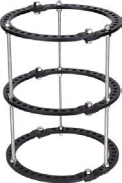 | Set |
| Lower Limb Lengthening External Fixator | GX301003 | 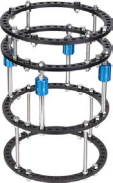 | Set |
| Tibial And Femur Fracture Ring Fixator-l | GX301004 | 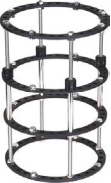 | Set |
| External Elbow Joint Fixator | GX301005 | 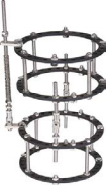 | Set |
| Tibia And Femur Fixation Orthopedics Fixator | GX301006 | 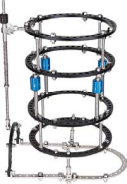 | Set |
| Taylor External Fixator | GX301007 | 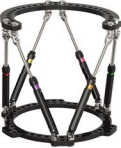 | Set |
| Knee Joint Fixator | GX301008 | 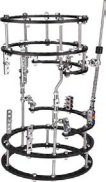 | Set |
| Ankle Joint Fixator | GX301009 | 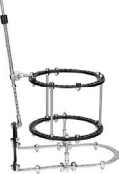 | Set |
Advantages of XC Medico's Products

CNC Preliminary Processing
The computer numerical control technology is used to precisely process orthopedic products. This process has the characteristics of high precision, high efficiency, and repeatability. It can quickly produce customized medical devices that conform to the human anatomical structure and provide patients with personalized treatment plans.
| 
Product Polishing
The purpose of orthopedic products polishing is to improve the contact between the implant and human tissue, reduce stress concentration, and improve the long-term stability of the implant. | 
Quality Inspection
The mechanical properties test of orthopedic products is designed to simulate the stress conditions of human bones, evaluate the load-bearing capacity and durability of implants in the human body, and ensure their safety and reliability. |

Product Package
Orthopedic products are packaged in a sterile room to ensure that the product is encapsulated in a clean, sterile environment to prevent microbial contamination and ensure surgical safety.
|  Product Warehouse Product Warehouse
The storage of orthopedic products requires strict in-and-out management and quality control to ensure product traceability and prevent expiration or wrong shipment. |  Sample Room Sample Room
The sample room is used to store, display and manage various orthopedic products samples for product technology exchanges and training. |
The Process To Cooperate With XC Medico
1. Ask Xc Medico Team For Lower Limb Lengthening External Fixator Product Catalog.
2. Choose Your Interested Lower Limb Lengthening External Fixator Product.
3. Ask For A Sample To Test Lower Limb Lengthening External Fixator.
4.Make An Order Of XC Medico's Lower Limb Lengthening External Fixator.
5.Become A Dealer Of XC Medico's Lower Limb Lengthening External Fixator.
The Advantages To Be A Dealer Or Wholesaler Of XC Medico
1.Better Purchase Prices Of Lower Limb Lengthening External Fixator.
2.100% The Highest Quality Lower Limb Lengthening External Fixator.
3. Less Ordering Efforts.
4. Price Stability For The Period Of Agreement.
5. Sufficient Lower Limb Lengthening External Fixator.
6. Quick And Easy Assessment Of XC Medico's Lower Limb Lengthening External Fixator.
7. A Globally Recognized Brand - XC Medico.
8. Fast Access Time To XC Medico Sales Team.
9. Additional Quality Test By XC Medico Team.
10. Track Your XC Medico Order From Start To Finish.
Lower Limb Lengthening External Fixator: A Comprehensive Guide
Lower limb lengthening has revolutionized orthopedic treatments for patients with congenital or acquired limb length discrepancies, deformities, or other complex conditions. The Lower Limb Lengthening External Fixator is a sophisticated device that enables precise bone lengthening and deformity correction. This comprehensive guide explores the device's functionality, features, applications, and market trends to provide medical professionals, students, and researchers with an in-depth understanding of its significance.
What is Lower Limb Lengthening External Fixator?
A Lower Limb Lengthening External Fixator is a specialized orthopedic device designed to gradually lengthen bones in the lower extremities. This external device works through a process known as distraction osteogenesis, where the bone is surgically cut, and the fixator gradually separates the bone segments, allowing new bone tissue to grow in the gap.
The device consists of external rings or frames connected by rods and wires. These components allow surgeons to control the rate and direction of bone lengthening accurately. Lower limb lengthening is commonly used for correcting conditions such as limb length discrepancies, congenital deformities, or injuries resulting in bone loss or short stature.
Lower Limb Lengthening External Fixator Features
Precision Control
Surgeons can adjust the device in small increments (e.g., 0.5–1 mm per day) for optimal bone growth.
Versatile Configurations
The fixator accommodates a variety of anatomical and fracture-specific requirements.
Multiplanar Adjustment
The device enables corrections in multiple planes, including lengthening, angulation, and rotation.
Durable Materials
Constructed from high-strength, biocompatible materials such as stainless steel or titanium to withstand stress and minimize rejection.
Minimally Invasive Application
The device is applied externally, reducing trauma to surrounding soft tissues.
Compatibility with Software
Advanced fixators often integrate with digital planning tools for precise preoperative and postoperative adjustments.
Lower Limb Lengthening External Fixator Advantages
Gradual and Natural Lengthening
The slow, controlled process promotes natural bone regeneration and adaptation of soft tissues.
Soft Tissue Preservation
Unlike internal implants, the external fixator minimizes damage to muscles, nerves, and blood vessels.
Customizable Adjustments
Surgeons can fine-tune the lengthening process during recovery without additional surgery.
Correction of Deformities
The fixator allows simultaneous correction of angular or rotational deformities.
Improved Bone Healing
The distraction osteogenesis process stimulates robust bone growth, reducing the risk of non-union.
Non-Permanent Hardware
Since the device is external, it is easily removed once the treatment is complete, avoiding long-term hardware complications.
Lower Limb Lengthening External Fixator Treatment of Fracture Types
Limb Length Discrepancies
Effective for congenital or acquired differences in leg length.
Bone Defects
Used to bridge gaps resulting from trauma, infection, or tumor resection.
Congenital Deformities
Corrects abnormalities such as bow legs, knock knees, or rotational deformities.
Complex Fractures
Stabilizes and promotes healing in comminuted or open fractures.
Short Stature
Occasionally used in stature lengthening procedures for cosmetic or medical reasons.
Risks of Lower Limb Lengthening External Fixator Surgery
Pin Tract Infections
Infection at the sites where pins or wires enter the skin is a common concern, requiring regular cleaning and monitoring.
Pain and Discomfort
Patients may experience discomfort during the lengthening process, necessitating pain management strategies.
Delayed Healing
Factors such as poor bone quality or improper adjustments can lead to delayed union or non-union.
Joint Stiffness
Prolonged use of the device may cause joint stiffness or reduced range of motion in adjacent joints.
Soft Tissue Tightness
Excessive lengthening can strain surrounding muscles, nerves, and blood vessels.
Psychological Impact
The visible and long-term nature of the device may affect the patient's mental well-being, requiring counseling and support.
Lower Limb Lengthening External Fixator Future Marke
Increasing Demand for Limb Correction Procedures
A growing awareness of limb length discrepancies and deformities is driving demand for effective treatments.
Technological Advancements
Innovations such as smart fixators with automated adjustments and digital integration are expanding the device’s capabilities.
Global Aging Population
The rise in age-related orthopedic conditions, such as fractures and deformities, is boosting the need for external fixation solutions.
Emerging Markets
Adoption of advanced orthopedic technologies is increasing in developing countries, contributing to market growth.
Research and Development
Ongoing studies are refining the fixator design and materials, improving patient outcomes and expanding its applications.
Summary
The Lower Limb Lengthening External Fixator is a groundbreaking device that offers precise and reliable solutions for limb length discrepancies, deformities, and complex fractures. Its advanced features, combined with its versatility and advantages, make it a critical tool in modern orthopedic practice. While the procedure carries some risks, careful planning and postoperative care ensure successful outcomes. As technology and market demand continue to evolve, this device is set to remain at the forefront of orthopedic innovation, providing hope and mobility to patients worldwide.
Warm reminder: This article is for reference only and cannot replace the doctor's professional advice. If you have any questions, please consult your attending physician.
English
Русский
简体中文
繁體中文
العربية
Français
Español
Português
Deutsch
italiano
日本語
한국어
Nederlands
Tiếng Việt
ไทย
Polski
Türkçe
አማርኛ
ພາສາລາວ
ភាសាខ្មែរ
Bahasa Melayu
ဗမာစာ
தமிழ்
Filipino
Bahasa Indonesia
magyar
Română
Čeština
Монгол
қазақ
Српски
हिन्दी
فارسی
Kiswahili
Slovenčina
Slovenščina
Norsk
Svenska
українська
Ελληνικά
Suomi
Հայերեն
עברית
Latine
Dansk
اردو
Shqip
বাংলা
Hrvatski
Afrikaans
Gaeilge
Eesti keel
Māori
සිංහල
नेपाली
Oʻzbekcha
latviešu
অসমীয়া
Aymara
Azərbaycan dili
Bamanankan
Euskara
Беларуская мова
भोजपुरी
Bosanski
Български
Català
Cebuano
Corsu
ދިވެހި
डोग्रिड ने दी
Esperanto
Eʋegbe
Frysk
Galego
ქართული
guarani
ગુજરાતી
Kreyòl ayisyen
Hausa
ʻŌlelo Hawaiʻi
Hmoob
íslenska
Igbo
Ilocano
Basa Jawa
ಕನ್ನಡ
Kinyarwanda
गोंगेन हें नांव
Krio we dɛn kɔl Krio
Kurdî
Kurdî
Кыргызча
Lingala
Lietuvių
Oluganda
Lëtzebuergesch
Македонски
मैथिली
Malagasy
മലയാളം
Malti
मराठी
ꯃꯦꯇꯥꯏ (ꯃꯅꯤꯄꯨꯔꯤ) ꯴.
Mizo tawng
Chichewa
ଓଡ଼ିଆ
Afaan Oromoo
پښتو
ਪੰਜਾਬੀ
Runasimi
Gagana Samoa
संस्कृत
Gaelo Albannach
Sepeti
Sesotho
chiShona
سنڌي
Soomaali
Basa Sunda
Wikang Tagalog
Тоҷикӣ
Татарча
తెలుగు
ትግንያውያን
Xitsonga
Türkmençe
संस्कृत
ئۇيغۇرچە
Cymraeg
isiXhosa
ייִדיש
Yorùbá
isiZulu
























 Product Warehouse
Product Warehouse Sample Room
Sample Room









